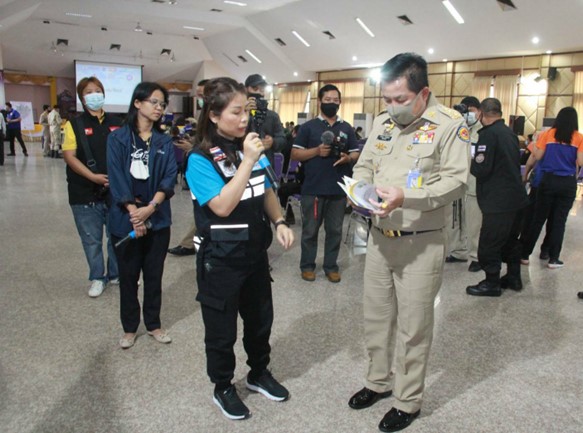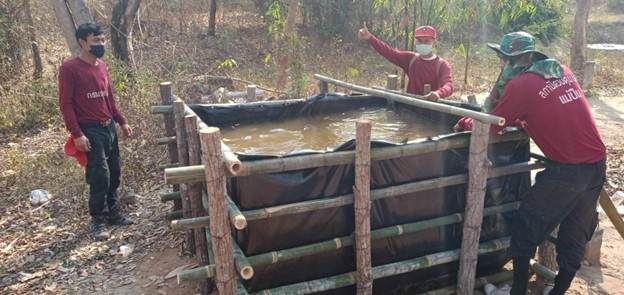- About Us
-
Who we are
-
- Publications
-
- ADPC Academy
-
MediaADPC'S NEWS
International Women’s Day, 2023 Highlight: Dr. Nion Champions the Use of Satellite Data for Improving Air Quality Through a Unique ADPC-USAID-NASA Partnership International Women’s Day, 2023 Highlight: Dr. Nion Champions the Use of Satellite Data for Improving Air Quality Through a Unique ADPC-USAID-NASA Partnership
8 Mar 2023
Chiang Rai, Thailand

Photo: Dr. Nion (left) with Governor Prachon Pratsakul of Chiang Rai Province (center) during the launch of the Smoke Watch App in February. Photo Credit: Fulfill Social Enterprise Limited Partnership
This International Women's Day, we recognize and celebrate the work of Dr. Nion Sirimongkonlertkul from Rajamangala University of Technology, Thailand. Over the last decade, Dr. Nion has championed the advancement of transformative technologies for decision making using satellite data and geospatial information.
In collaboration with the Asian Disaster Preparedness Center (ADPC), Dr. Nion and her team developed the Smoke Watch Application, which was awarded Thailand's National Innovation Award, 2021. Smoke Watch, developed using data from ADPC's Mekong Air Quality Explorer tool, pin-points the exact location of fires as they happen which enables first responders and forest rangers to undertake targeted interventions to put out the fires. Smoke Watch is a great demonstration of the innovative applications made possible using data from SERVER-Southeast Asia.
SERVIR-Southeast Asia is a partnership between ADPC, the United States Agency for International Development (USAID) and the U.S. National Aeronautics and Space Administration (NASA) that uses publicly available satellite imagery and technologies to address challenges related to water resources, disasters, climate resilience, agriculture, and ecosystems in Southeast Asia.
In Thailand, March marks the onset of the dry and hot season. Dry vegetation coupled with small human-made fires has often resulted in forest fires getting out of control. Forest fires release particulate matter (PM) into the atmosphere. PM is a common proxy indicator of air pollution. PM2.5 refers to microscopic particles with a diameter of 2.5 microns or less - that is 30 times smaller than the diameter of the human hair.
Forest fires impact the health of communities living in adjoining areas, and beyond. PM2.5 released during forest fires and agricultural burning can penetrate the lung barrier and enter the blood system. Chronic exposure to PM2.5 increases the risk of developing cardiovascular and respiratory diseases, as well as lung cancer. According to recent research published by The Energy Policy Institute at the University of Chicago, long-term exposure to fine particulate pollution is shortening the average life expectancy in Thailand by more than two years.
"I am allergic to haze and visit the doctor every year, so I've been trying to come up with solutions for the PM2.5 problems caused by open burning," says Dr. Nion. "In 2007, the province where I lived had the highest PM2.5 in Thailand - it was when I had my first son." She approached various agencies to find solutions. "Everyone tried their best, the problem was very complex and so I focussed on what I could do to support," she adds, reflecting on her journey of addressing air pollution.
Dr. Nion has been successful in putting together a multi-stakeholder coalition to tackle forest fires in Chiang Rai, including the government, the private sector, academia and NGO's - a first of its kind in Thailand. She has also engaged with school children in areas adjoining the forest fire hotspots, teaching them about the impact of forest fires and role of satellite data in forest fire detection. Dr. Nion developed the Blue School app for women and children to provide access to satellite data for monitoring PM2.5 and for sharing their stories in their communities.
"Previously, it was very difficult and time-consuming for the Forest Fire Department to filter and localize fire hotspots as they would rely on the community for determining the exact location of the fires," explains Dr. Nion. "Near real-time fire hotspot data from ADPC's Mekong Air Quality Explorer tool is instrumental in pinpointing fire hotspots. The faster we identify the fire hotspots, the quicker we can respond to the fires, as a result, less PM 2.5 pollution is released into the atmosphere."
The use of ADPC's satellite-based data by the Smoke Watch App for locating and managing forest fires has proven successful in Chiang Rai. Managing forest fires and agricultural burning, one of the major sources of air pollution, is an important step toward improving air quality in Thailand.

Photo: Firefighters construct makeshift water tanks together with the community, with support from the government. In the absence of piped water in remote forest areas, water from these tanks is used to put out fires. Photo Credit: Forest Fire Control, Protected Areas Regional Office 15 (Chiang Rai)
ADPC's Mekong Air Quality Explorer tool combines satellite data and models from NASA to enable monitoring and forecasting of air quality in Thailand across a larger area; it does not rely solely on localized monitoring stations. This information helps authorities devise data-driven policies and strategies to tackle air pollution in Thailand. The decision support tool has been developed in close collaboration with Thailand's Pollution Control Department (PCD) and the Geo-Informatics and Space Technology Development Agency (GISTDA) – Thailand's space agency.
Latest NewsRelated Trainings
-